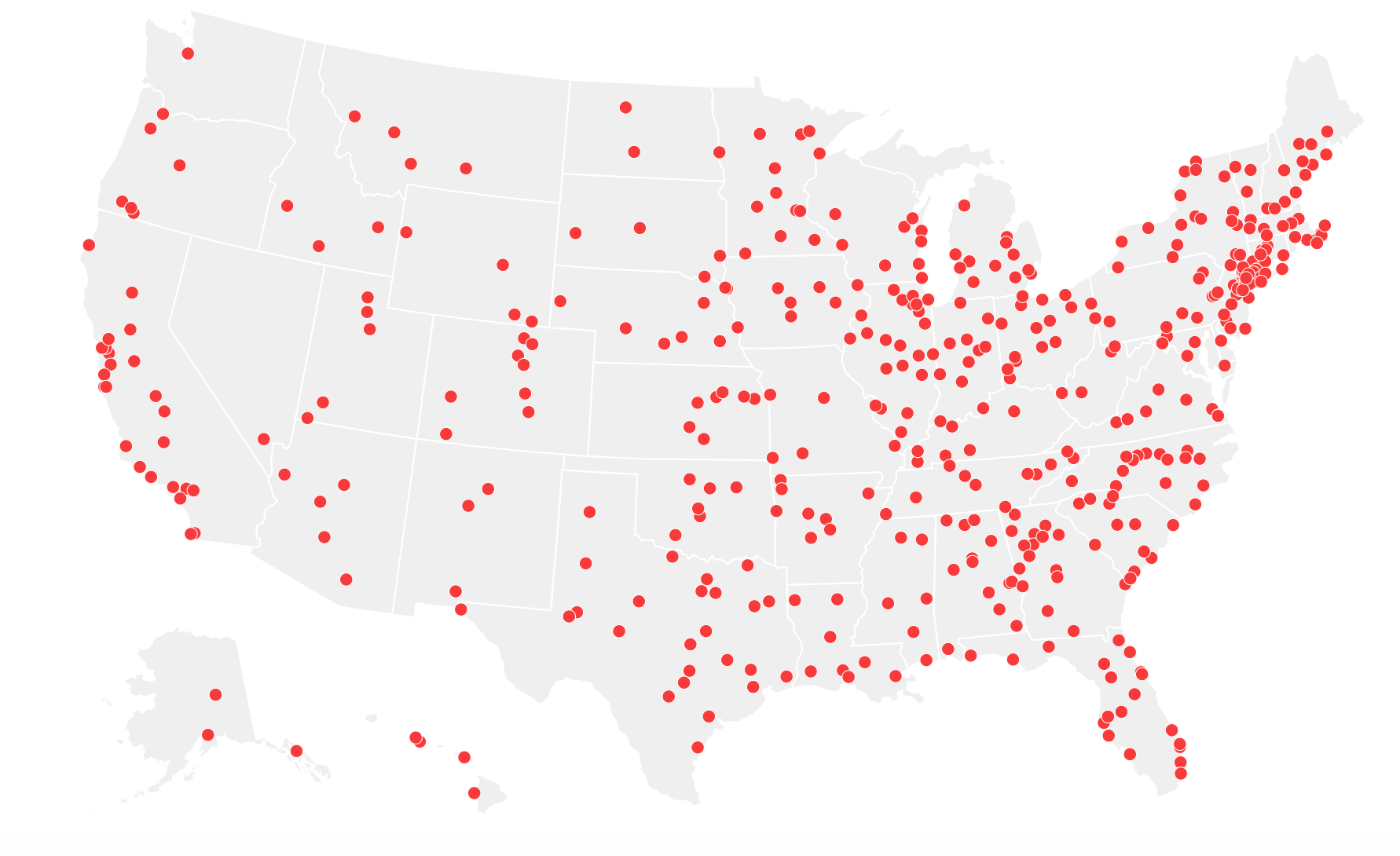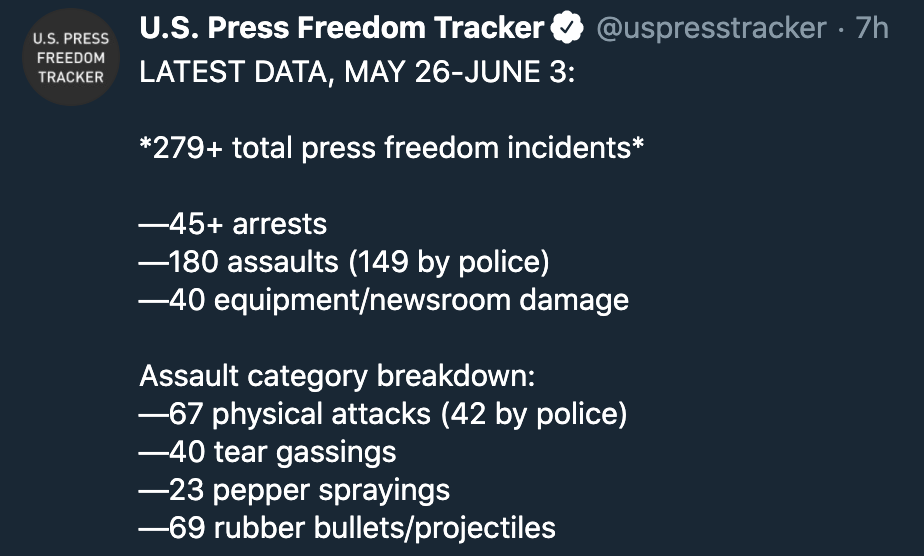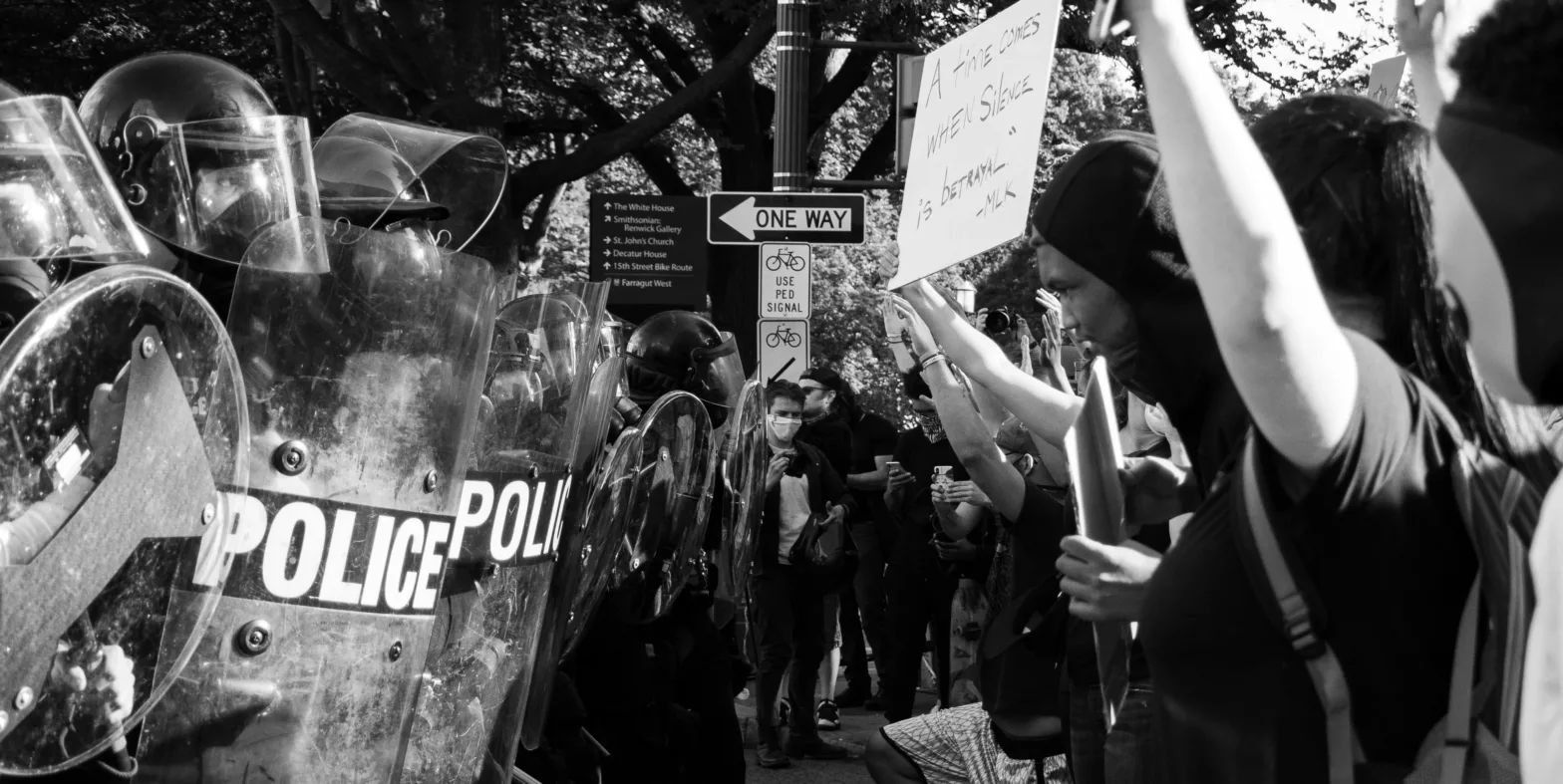Since the killing of George Floyd on May 25 by police in Minneapolis, the country has erupted in waves of protest and police action. News coverage has followed every step, but where you get your news likely has an impact on how you interpret events. Even the subtlest of word choices by journalists can be the difference between a protest and a riot, tear gas and smoke canisters, and a murder or a death. The media holds a lot of responsibility for which direction the conversation proceeds moving forward, as their words have an outsized influence on public opinion.
With this in mind, this week we analyzed the titles of 4,959 articles (from 279 news outlets) about the protests between May 25 and June 6 to see how the media, in parts and as a whole, might be influencing how the American public interprets and responds to recent events. While seeing the prevalence of certain words tells us one story, the relative absence of other words tells us entirely another.
See our How It Works page for more information on our article database and how we track article credibility.
News Coverage and Protests
The notion that news coverage helps shape protest movements and responses to them is hardly new, and we can see a number of those forces at work. Coverage of protests has been found to vary by issue. In examining 777 news articles about protests in Texas from 2017, Danielle Kilgo, an assistant professor of journalism at Indiana University, found the tenor of news articles to fluctuate depending on the subject matter. Protests relating to immigration or health and the environment were more likely to receive legitimizing coverage — that is “substantially mentioning protester’s demands, agendas, goals and grievances” — while protests about anti-black racism and the rights of indigenous peoples received the least legitimizing coverage.
Please check your email for instructions to ensure that the newsletter arrives in your inbox tomorrow.

Otherwise, we also see some evidence of the “protest paradigm” — a concept which suggests that news coverage of protests tends to reinforce the status quo by generally redirecting discussion to the events of protests rather than the reasons for protesting. This is hard to measure across our entire sample, but there are examples of this playing out on the left, “Military crackdown looms in Minneapolis to stop unrest” (LA Times), as well as the right, “Progressive Politicians Watch as Minneapolis Burns” (City Journal).
Of course, just analyzing titles is not a perfect measure of the state of journalism during these times; articles often have headlines meant to drive engagement, through curiosity or outrage, when the text within is less inflammatory, more balanced, and cognizant of the issues at play. However, with social media feeds a constant stream of news articles and “hot takes,” articles are often engaged with or seen solely through their headlines, meaning these few words can have immeasurable influence on how people interpret an issue, even without the article being read.
What the Headlines Say
In many ways, our analysis of headlines supports some of the stereotypes one might expect. For example, articles from outlets on the right featured “riot,” “riots,” or “rioting” in 12.9% of all article titles, while only 2.6% of article titles on the left featured those terms. Similarly, article titles on the right were twice as likely (8.1%) to use some variation of the word “loot” than the left (3.8%). Conversely, articles on the left were 10% more likely (43.7%) to feature a variation of the term “protest” than those on the right (33.8%), and 7.8% of articles on the left featured the term “non-violent,” which didn’t appear in any article titles on the right. These differences suggest that readers of right-leaning publications may be more likely to interpret recent events as out of control and violent, while left-leaning readers may be more likely to see events as justified public protests. In this way, the words chosen influence the overall context for public debate.
In other elements, what is said by outlets on both sides of the spectrum can have significant overlap, suggesting the relative importance of an element to the overall discussion. For example, of articles focusing on the protests, 10.1% on the left and 8.1% from the right mention President Trump in the title, the implication perhaps being that presidential leadership — or lack thereof, depending on who you ask — is closely tied to the unrest. Whether President Trump’s role is seen as positive or negative, both sides agree that he is a relevant factor to recent events.
Similarly, the left and the right make frequent mentions of “police,” at 40.5% and 39.8%, respectively. Given the role of the officers in George Floyd’s death and response to protests, this should be no surprise. While the relative interpretations of police behavior in recent days may vary, there is agreement that police are essential to understanding what has transpired thus far — and likely where we go next.
What the Headlines Don’t Say
As Dr. Kilgo mentions, there is a tendency for journalists to “pay little attention to protests that aren’t dramatic or unconventional.” This seems to play out in our data, with very few titles focusing on the peaceful nature of many of the protests related to George Floyd. Fewer than 2% of all articles use the word “peaceful,” but there have been more than 450 protests, rallies, and vigils since May 25, and violence seems to be very much the exception rather than the rule. By failing to report on the peaceful nature of many protests—or even many instances of peaceful police involvement—media coverage can skew the public’s interpretation of events.

Sites of protests, rallies, and vigils related to George Floyd – CNBC
In the same vein, anyone who has been on social media in the last few days has undoubtedly witnessed police actions involving tear gas, rubber bullets, and other “riot control” type tactics. Such events are very much “dramatic or unconventional.” However, relatively few titles mention implements such as “gas” (<2.2%), “tear gas” (<1.5%), and “rubber bullets” (<0.5%) or the conceptual issues at play such as “police brutality” (<2.5%) and “police militarization” (<1.2%). Even if public interest in discussing these issues appears high, the public space afforded to them via coverage by major media outlets appears to remain low.
Likewise, a worrying spate of police violence against journalists has gone relatively underreported. As of June 6, U.S. Press Freedom Tracker has reports of as many as 208 assaults on journalists by police, but just 0.7% of news titles (36 stories) mention “journalist” or “journalists” in the context of violence against them.

What to Read
As with our past work, it’s impossible to point to a single article or outlet for a definitive understanding of events. The best strategy continues to be to read widely from outlets and authors with demonstrated records of credible, well-researched journalism. Luckily, The Factual’s database lets us zero in on which outlets those are. Here’s our top picks for news about the recent protests from the left and the right.
On the Left
FiveThirtyEight – Average Credibility Grade: 74.4% – Number of Articles: 7
Famous for analysis of opinion polls and polling aggregation, FiveThirtyEight also features analysis on topics ranging from politics to sports. In recent days, that analysis has focused especially on statistics about the police.
Best article: “Why It’s So Rare For Police Officers To Face Legal Consequences”
(Authors: Amelia Thomson-DeVeaux, Nathaniel Rakich, and Likhitha Butchireddygari; Credibility Grade: 84%)
NBC News – Average Credibility Grade: 72.9% – Number of Articles: 52
Much more of a traditional news outlet, NBC News offers daily coverage of events, following the latest twists and turns as protests spread throughout the U.S., as well as several pieces exploring the underlying issues at play.
Best article: “Officer who stood by as George Floyd died highlights complex Asian American, black relations”
(Author: Kimmy Yam; Credibility Grade: 86%)
The Intercept – Average Credibility Grade: 72.8% – Number of Articles: 13
The Intercept’s coverage has focused almost entirely on the performance of the police and the shortcomings of police reform, which is no surprise given their overall mission to hold “the powerful accountable through fearless, adversarial journalism.”
Best article: “The George Floyd Killing in Minneapolis Exposes the Failures of Police Reform”
(Authors: Alice Speri, Alleen Brown, and Mara Hvistendahl; Credibility Grade: 87%)
Please check your email for instructions to ensure that the newsletter arrives in your inbox tomorrow.
In the Center
CNET – Average Credibility Grade: 78.8% – Number of Articles: 5
CNET — a media site best known for its coverage of technology and consumer products — put out a number of excellent articles covering technology’s role in the protests, from police surveillance to social media and misinformation.
Best article: “Amid George Floyd protests, weaponized misinformation floods social media”
(Author: Dara Kerr and Shara Tibken; Credibility Grade: 83%)
The Conversation – Average Credibility Grade: 76.2% – Number of Articles: 6
Also featured as one of our top outlets for Covid-19 news, The Conversation provides a platform for academics to write accessibly about pressing issues, bringing their expertise to a free and open platform.
Best article: “Riot or resistance? How media frames unrest in Minneapolis will shape public’s view of protest”
(Author: Danielle K. Kilgo; Credibility Grade: 83%)
On the Right
Reason – Average Credibility Grade: 71.0% – Number of Articles: 28
Reason is a libertarian magazine which regularly appears as the best performing outlet on the right in our credibility database. In recent days, the magazine has been discussing the misdeeds of policing institutions, much like counterparts on the left.
Best article: “Activists Demand Justice for Breonna Taylor, Whose Killers Are Still Employed as Louisville Cops”
(Author: Elizabeth Nolan Brown; Credibility Grade: 85%)
Dallas Morning News – Average Credibility Grade: 70.3% – Number of Articles: 6
The Dallas Morning News has featured some of the most credible articles on the right related to the protests, though much of their coverage was specific to the protests and police action in Dallas.
Best article: “Texas GOP leaders try to distance themselves from Facebook posts Democrats denounce as ‘racist’”
(Author: Robert T. Garrett; Credibility Grade: 85%)
Washington Examiner – Average Credibility Grade: 67.7% – Number of Articles: 222
The Washington Examiner has published the highest number of articles about the protests besides Fox News. With so many articles and authors, it’s no surprise that their coverage includes both positive and negative perceptions of the protests and underlying issues.
Best article: “Ending qualified immunity: Five things to know about the legal obstacle protecting police officers who violate the rights of citizens”
(Author: Madison Dibble; Credibility Grade: 88%)
Conclusion
We need to be cognizant that the words journalists choose to describe events — as well as the words they choose not to include — can shift our perceptions for better or for worse. Our perceptions in turn inform our actions or inaction and thus shape the world around us. In that context, careful news consumption is key: we can’t afford to miss the forest for the trees.

